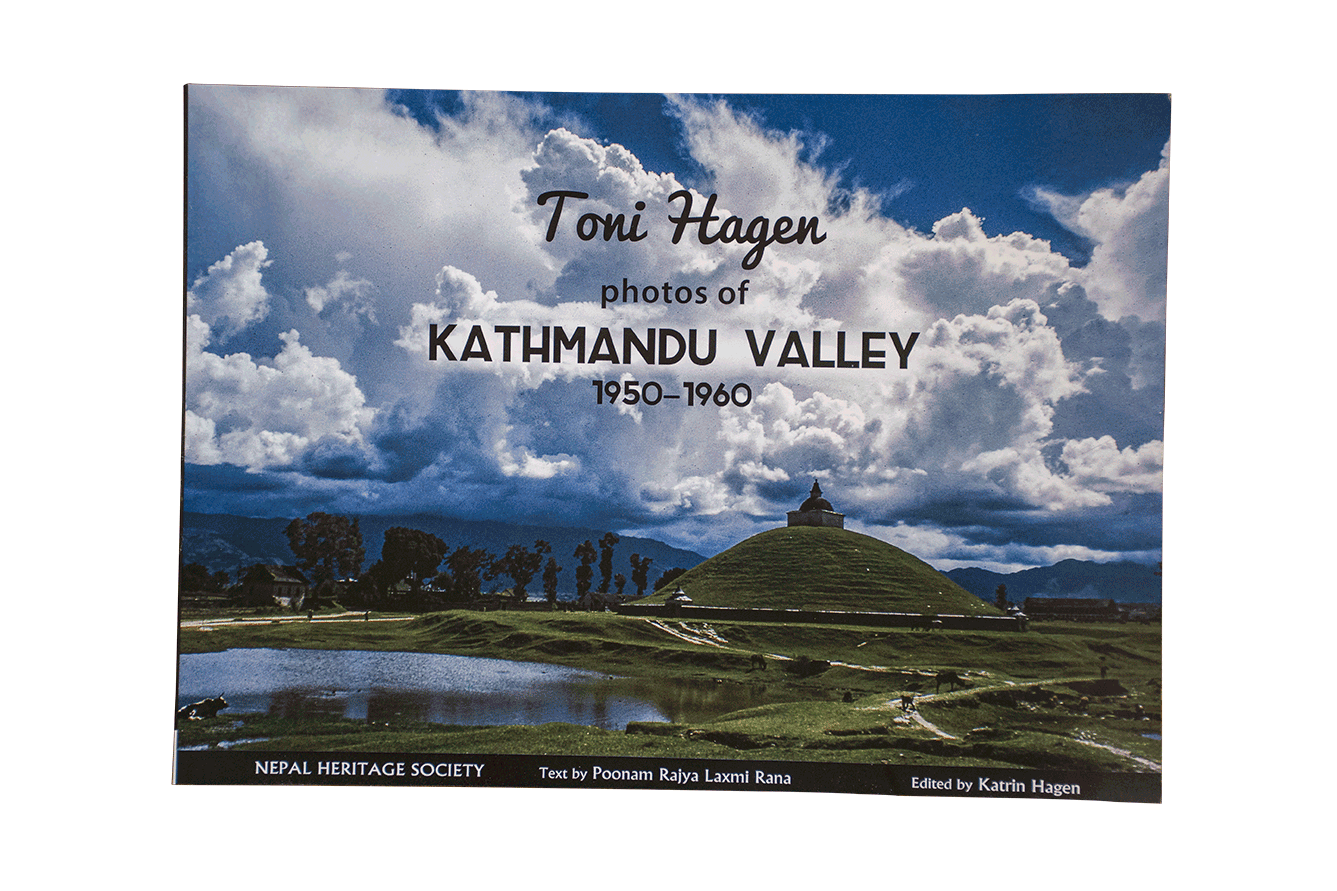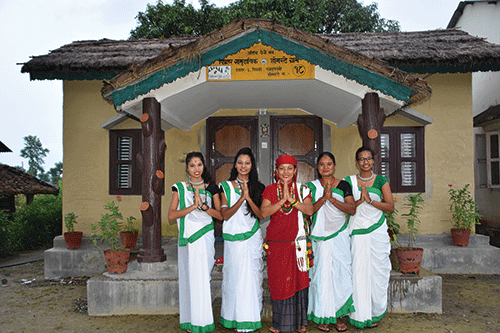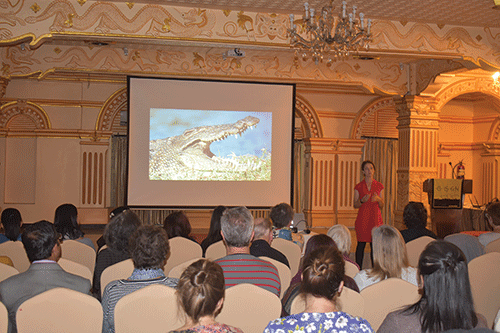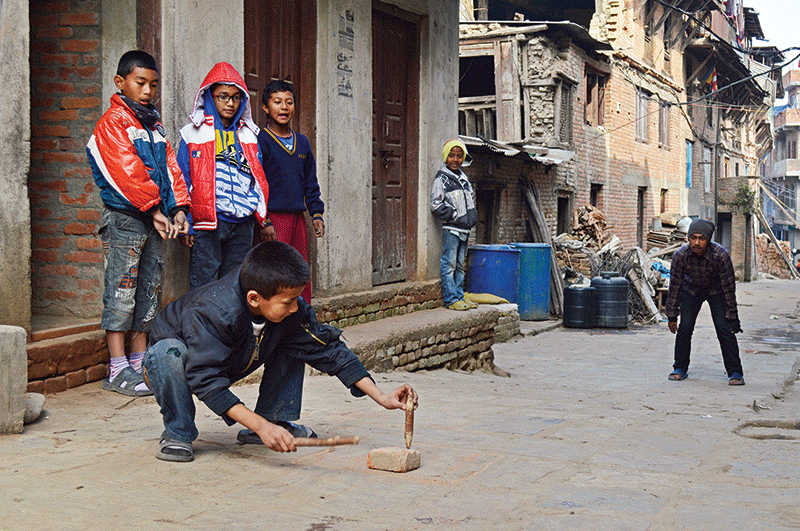"I want to ride my bicycle." -Queen, the Singer
Push to the max, persevere,struggle constantly to top your last record or to best the com petition. These are the marks of competitive sportsmen and women the world around. Nepali athletes are no different. They awake early, rain or shine, cold or warm, to meet the challenge.
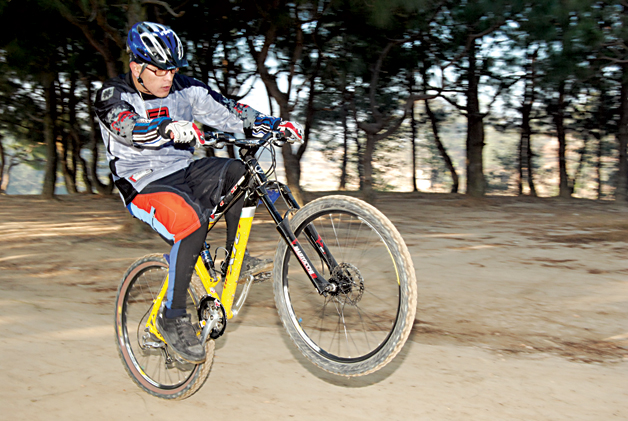
Shooting this month’s ECS cover photo was like that. It began early one foggy morning, when seven dedicated mountain bikers gathered in front of the Ambassador Hotel. When we arrived, wearing multiple layers against the cold, they were dressed in typical minimal biking attire despite the cold, and warming up with stretches. A colorful lot, both in personality and in terms of their various biking gear, they included old timers, jump specialists, past race winners and a few along just for the fun and exercise. We established a rendezvous point and off we went, they on their bikes, cross-country, and we on motorbikes with camera gear and notebooks, on established roads. At first, we zoomed ahead, while they went overland along familiar routes down narrow lanes, across farmers’ fields and along bumpy paths, with some of the valley’s spectacular rural scenery as their backdrop. When we lost them on a hilltop, two cyclists came down to guide us to the photo spot. “Now, let the photo shoot commence”, someone said in Nepali.
Mountain biking
Mountain biking is an off-road adventure sport, one that requires physical endurance, bike handling acumen and technical skills and (since it takes one to far places) self-reliance. Mountain biking can be pursued anywhere from backyard to gravel road and mountain trail. In mid-1970’s, an adventurous group in Marin Country, California, began racing down Mt Tamalpais, the first organized ‘mountain biking’ as an American outdoor pastime. It is considered as one of the fastest games to be adopted by the Olympics (1996) and by the Asian Games (1998). What sets mountain bikes apart from regular bicycles is a combination of knobby tires, large round-frame structural tubing and strong suspension or shock absorbers. Mountain biking is not cheap, as bike, parts, maintenance and attire add up to a small fortune. It is the adrenaline rush and the beauty of the sport, however, that captivates dedicated bikers.
A biker named Joe Breeze built the first mountain bike in 1977, and the first to be mass-produced went on sale in 1982. Quite quickly, the International Cycling Union (UCI) was formed to govern the sport. The UCI established the point system that governs international ranking, world championships and Olympic qualifications.
Know your bike
Each bike is suited to a specific body geometry, so care should be taken while buying one. The pedals are most important. The height of the bike should allow the toe to touch the ground. The wheels should be tight, brakes require careful checking before riding, and tire pressure should be adjusted depending on off- or on-road riding. The frame (the skeleton of the bike) comes in a variety of sizes to suit body size and gender. There should be a two to three inch gap clearance the body and the bar. The handle distance should allow a slight bend in the arms. To climb the steepest hills mountain bikes are equipped with a multiple gear set. Even selecting the right saddle is important, as you will find out after many hours of riding. Tires are also important and should not be compromised, for they provide the necessary traction for mountain riding. In recent years, spring suspension has become a standard feature. All in all, the best advice is to do the research for your particular biking needs and body size, before you buy.
Since mountain biking is dangerous, safety standards have been developed along with aerodynamic helmets, gloves and knee pads. The bikers and racers wear body-fitting spandex outfits that are breathable, sweat absorbing and aerodynamic. Padding minimizes pressure, making the ride smooth and comfortable. Good grip on tires and shoes is important, and may spell the difference between staying on-course or ending up in the gutter. A repair kit is also important, and includes replacement tubes, a hand pump, chain cutter and chain oil. Bikers also carry chocolate or energy bars and drinking water for long distances runs and, for riding at night, bright reflectors.
Mountain biking in Nepal
Cycling began in Nepal merely as a mode of transportation, before there were many motor vehicles in the valley. The earliest bikes in Kathmandu were Indian or Chinese brands, owned mostly by the royal family and other elites. The first bike store was opened near Asan Tol in 1925 by Astha Narayan Manandhar and quickly became popular (the shop is still there and still owned by the Manandhar family). By the mid-1980s when Tibet opened up to the rest of the world, Nepal found itself in the midst of new bike touring and adventure activities. The 1983 Himalayan Mountain Bike Expedition to Mt Everest Base Camp, led by Craig Moffet and Brad Grunewald, opened up mountain biking in Nepal. When the Nepalese saw foreigners riding easily uphill they marveled at their unique bikes. ‘Gear wallas’, they called them: bikes with gears.
In his popular book, Bikes and Hikes, James Gambrione describes the history of mountain biking in Nepal. For example, it tells you that Francis Higgins opened Himalayan Mountain Bikes (HMB) in 1988, the first of its kind. James was HMB’s managing director for four years, founded the ‘Gear Walla Club’, and conducted the first races in Nepal. He describes the sport as “timeless, providing spiritual, mental and physical development all in one”.
Chimmi Gurung, current president of the Nepal Cycling Association (NCA) regards Nepal as one of the world’s best destinations for mountain biking. “Nepal is a transit point for world touring sportsmen. Mountain biking is riding off-roads of which Nepal has plenty”, he says. NCA organizes a national level championship every year, an event that certifies racers as professional riders.
Biking in Nepal is a fantastic way to explore the country. The foothills of the Himalayas and the Kathmandu valley rim provide some challenging venues for riding, and great scenery. There is a diversity of terrain, varied climate, and pleasant rides up from the Terai plains through the subtropical mid-hills, and into the more challenging trans-Himalayan zone.
Unlike other places where it may take hours to reach a suitable off-road venue for biking, from Kathmandu the rider can experience exhilarating cross-country trails in 20 or 30 minutes. The Kathmandu valley is small enough to be familiar, yet large enough to get lost in, making it an ideal mountain biking adventure playground.
A dozen or more bike races are held each year in Nepal, run by the NCA and private companies. Some have received worldwide attention, such as the Himalayan Mountain Bike Race, the Nepal National Mountain Bike Championship and the newest, the long-distance ‘Yak Attack’. Most of them attract foreign bikers racing alongside Nepal’s finest. This past year’s National Championship was budgeted at over 200,000 rupees, with some large cash prizes. The Annapurna Triathlon is also popular, combining biking with running and swimming. Some consider it to be “the most beautiful race in the world”.
THREE Personalities on Nepal’s Mountain Biking Scene
Sonam Gurung: Nepal’s mountain bike guru
What do you get if you cross a Buddhist monk with a kick boxer? It’s Sonam Gurung, Nepal’s top mountain bike guide, according to an article in Mountain Biker’ magazine of July 1994. Sonam Gurung, 54 years old, from Manang District, has contributed an immense amount to mountain biking in Nepal. He gave Manang residents their first view of a bicycle, was the first Nepali to cycle to Everest Base Camp in 1988, won Nepal’s first official mountain bike race with a cash prize of 500 rupees, and has guided many Nepali youths in mountain biking and racing. In relating all this, Sonam’s undaunted love for mountain biking and Nepal spreads across strong face.
Sonam has more than 20 years of experience of mountain biking in Tibet, India, Nepal and Bhutan. He is vice-president of Nepal Cycling Association (NCA). He is trained in first aid, safety and cycle mechanics. He starts his day at the Jyatha outlet of Dawn till Dusk at 9:30am preparing the bicycle haven for Nepalese and tourists, alike. His shop provides all mountain biker needs: cycles, parts, repairs and information backed up by a wealth of personal experience. The shop serves as a sort of memorial to his cycling life, with an array of medals, signed guest books, and mountain biker magazines featuring the history of mountain biking in Nepal and describing the energy of the man himself.
Dawn till Dusk, one of Nepal’s leading mountain bike tours and expeditions companies, first opened in 1996 with Sonam and four cycles on Thamel road. Basanta Shrestha of the Kathmandu Guest House offered him a room where the main office is currently located. “Back at home in Manang”, he says, “my mother strictly said when it comes to working, start from early morning till late at night. This thought stuck with me and a friend and Lonely Planet writer named John translated it as Dawn till Dusk” he recalls. “I run it with my brother, Chimmi Gurung. I cannot read or write, so we share our expertise. Of course, Chimmi also is a professional racer.”
Sonam’s dedication, stamina, patience and love for the biking sport is laudable. Over the course of his life, he’s also been a porter, monk, bike tour guide, kick-boxer, racer, teacher and entrepreneur. He takes pride in it all. “People might think I’ve become rich from the bike shop and some might also wonder if the old chap is still racing, but I hope to inspire the youth by it all. They cannot hold back in a country that is so well fitted for adventure sports. Through bike tourism I wish to contribute to my nation,” he says. He carries his International Cycling Union license in his wallet and has a large heart of passion for mountain biking in Nepal. Sonam Gurung is a lean and strong minded son of Nepal, a living inspiration.
Nirjala Tamrakar: Suspend conventional thought
The biking department of Himalaya Expedition features Nirjala Tamrakar, Nepal’s first woman mountain bike racer. She has ridden from an early age, beginning with the help of a technical racer named Rubin Shakya. Nirjala’s first race was in the Action Asia Himalayan Mountain Bike Series 2001, when she came in second in her category. For her efforts, she was given a Siemens mobile phone by the Australian sponsors. She is proud to see that racing event being featured time and again on the Adventure TV channel.
There is a furious stare across her face as she laments her luck at the 8th Nepal National Mountain Bike Championship. In the very first lap she suffered a tire puncture; nonetheless, she came in second among the Nepali racers, and fourth overall. For training, she rides extensively three to four days a week, but knows that too much exercise is not recommended. In her early years of biking, daily practice took her to places like Dakshinkali, Godavari and Nagarkot each morning, ending at her place of work. The heavy riding schedule made her tired and sleepy, so she frequently slept over lunch. Her colleagues encouraged her to go to work for a mountain biking company, which she now does.
Referring to the challenges of the game, she talks of the risks associated riding downhill without health or accident insurance. At first, her family was concerned about her biking in far-off places; but now, she says, her whole life is affected by it. She takes great care about what she eats and drinks and how she exercises. When asked about other female riders, she says that there are some, but they don’t seem very serious. Races are very important, she says, and every race counts as a way for bikers to test themselves against others. Being the best is always good, she says, and she hopes to continue racing for the next 20 years.
Some of Nirjala’s racing highlights include being the only Nepalese cycler in the Tenth South Asian Games (Colombo, 2006); a Lhasa to Kathmandu trip covering 1,150km in 17 days with Himalayan Expeditions; coming in first in the first Epic Mountain Bike Cross-Country Race of February 2006; and being first position in the recent Damauli to Bandipur Mountain Bike Race.
Surendra Rai: Two time National Championship Winner
Surendra Rai, aged 23, currently attends college and looks after one of the
oldest tour and expedition gear shop in Thamel. He also allocates a few hours for daily training, either by riding or physical fitness. Surendra is winner of the Seventh and Eighth Nepal National Mountain Bike Championships (2006 and 2007). At age 13 he came to Kathmandu from his home in east Nepal’s Udaypur District. He went to work in his brother’s shop, but was attracted to bicycle riding. Unable to afford a bike of his own, he started with his brother’s, and never looked back.
Surendra entered the National Championship race for the first time in 2003, took third prize and earned some very positive praise from the pros about his racing. In 2006, he took first position in the same race, and proudly received the biggest prize ever given, a frame of the French cycle ‘Commencial’, worth 850 Euros. After winning once, he says, you become wary that someone else will take away your title; so, to keep it for yourself, constant training, care in food habits, and enough rest and knowledge of biking as a whole is needed. He says that training and practice under all kinds of conditions keep the muscles from cramping; but he also points out that rest is of equal importance.
Rai says his current training is targeted towards the upcoming SAARC games in Bangladesh and next Asian Mountain Bike Championship scheduled for Nepal in 2008. He hopes to promote Nepal by participating internationally and that his experiences in national games will help him win an international medal.
Short takes
Call him ‘Baula’, Binod Nagarkoti
Jumping around with his mountain bike, the loud and boisterous Binod Nagarkoti has earned the name Baula (‘mad’) from his fellow riders. He is in the sport for rigorous exercise and stunts rather than racing. He and several other riders built special ramps at Kirtipur which were later destroyed, but that doesn’t stop him. Lately he’s been knocking on doors to get support to build new ramps for sports biking and with positives mindedness, he says, we are likely to see some in the near future.
Riding and art with Gyanmani Ray
Gyanmani Ray started mountain biking in 1996 and racing in 1998. He is a painter, and painting landscapes and sceneries seemed much easier with a bike, so he soon became a regular biker. While exploring areas for his art he has also become a trail finder for riders. He says riding makes him healthier and younger, and that the challenges and quick decisions on the road sharpen his brain.
Riding professionally with Sonam Lama
Racer and tour guide of Firante Treks, Sonam Lama joined in the sport in 1997. He has biked and toured in Nepal, Ladakh (northern India), and China, and has participated in many races. He calls biking and working for a bike company his first and last job. Although the game is one of high expense and low income personally, his career in biking has been bright, and he has seen the number of riders and good bikes increase in the valley.
Racing and antiques with Prayas Lama
Prayas Lama, aka ‘Mr Roadie’, has been riding professionally in races since 1998. He also owns an antique and handicraft shop in the southern part of Thamel, which serves as a meeting point where fellow racers discuss their days, lives, exciting trails, races and tomorrow morning’s cycling route. Cycling is injected in our blood, he says, and a racer cannot stay too far from cycling. Being on a bike and tackling tricky paths speedily becomes is his passion, Prayas tells us.
Terai rider Ram Krishna Timilsina
A teacher by profession, Ram Krishna Timilsina considers the biking sport as an addictive hobby. Timilsina says that bikes have not earned respect like other vehicles. Nepal is a paradise for mountain bikers but Nepali people haven’t given enough respect to the cycle as the most pollution-free and beneficial-for-health form of transportation, he says. He wishes there was more support for biking, which sometimes seems to receive special attention because it is perceived as a foreigner’s sport.
At present, there are more than a hundred mountain bike cyclists in Nepal. One cannot just be in it for racing and few can survive as professional bikers because the country’s situation does not allow much concentration on sports. We have all seen an increase in the number of cyclists, however, and how their energy and love for this adventure sport has endured. What keeps these mountain bikers polishing their cycles after riding in the dark hours? What makes them call their cycles ‘partner’ or ‘girlfriend’? What is it that invites so many tourists from different countries to take on our strenuous hilly paths and rough terrain? In part, perhaps, it is the mix of adventure and Nepal’s natural mountain beauty, along with a way to stay fit and travel at the same time. Mountain biking, especially racing, however, is not for the faint hearted. It requires enormous strength, practice and dedication. Riders who get genuine pleasure out of cycling and competition are most likely to keep on biking.


